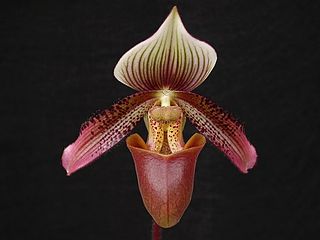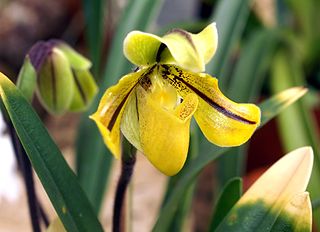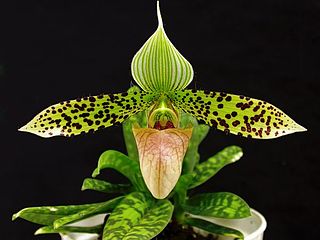
Paphiopedilum, often called the Venus slipper, is a genus of the lady slipper orchid subfamily Cypripedioideae of the flowering plant family Orchidaceae. The genus comprises some 80 accepted taxa including several natural hybrids. The genus is native to Southeast Asia, the Indian Subcontinent, southern China, New Guinea and the Solomon and Bismarck Islands. The type species of this genus is Paphiopedilum insigne.
The International Code of Nomenclature for Cultivated Plants (ICNCP) is a guide to the rules and regulations for naming cultigens, plants whose origin or selection is primarily due to intentional human activity. It is also known as Cultivated Plant Code. Cultigens under the purview of the ICNCP include cultivars, Groups, and grexes. All organisms traditionally considered to be plants are included. Taxa that receive a name under the ICNCP will also be included within taxa named under the International Code of Nomenclature for algae, fungi, and plants, for example, a cultivar is a member of a species.

Paphiopedilum armeniacum is a species of flowering plant in the orchid family, Orchidaceae. It is known commonly as the apricot orange paphiopedilum and golden slipper orchid. It is endemic to China, where it occurs only in Yunnan. It is also cultivated and has won prestigious awards at flower shows.

Paphiopedilum rothschildianum, commonly known as the Gold of Kinabalu orchid or Rothschild's slipper orchid, is a large sized clear-leafed species of orchid. It blooms with a tall inflorescence with up to six, large flowers. It is unique in the Corypetalum group by holding its petals almost horizontally, giving the flower a very distinctive appearance. The peak flowering period is from April to May.
Paphiopedilum adductum is a species of plant in the family Orchidaceae. It is endemic to Mindanao Island of the Philippines. Its natural habitat is subtropical or tropical moist lowland forests. It is threatened by habitat loss and overcollection.

Paphiopedilum barbigerum is a species of flowering plant in the family Orchidaceae known commonly as the beard carrying paphiopedilum. It is native to China, Vietnam, and Thailand. It is an endangered species due to habitat destruction and overcollection for the horticultural trade.

Paphiopedilum ciliolare is a species of flowering plant in the orchid family, Orchidaceae. It is known commonly as the short haired paphiopedilum. It is endemic to the Philippines.

Paphiopedilum dianthum is a species of flowering plant in the orchid family, Orchidaceae. It is native to China, Laos, and Vietnam. It is known commonly as the double flowered paphiopedilum.

Paphiopedilum fowliei is a species of plant in the family Orchidaceae. It is endemic to Palawan in the Philippines. Its natural habitat is subtropical or tropical moist lowland forests. It is threatened by habitat loss.
Paphiopedilum tigrinum is a species of plant in the family Orchidaceae. It is endemic to western Yunnan (China).

Paphiopedilum urbanianum is a species of plant in the family Orchidaceae. It is endemic to Mindoro in the Philippines. Its natural habitat is subtropical or tropical moist lowland forests. It is almost extinct in the wild, partly due to habitat loss, but even more so because of unsustainable collecting for the horticultural trade.

Paphiopedilum bullenianum is a species of orchid native to Malesia.

Paphiopedilum druryi is a species of orchid endemic to the Agastyamalai Hills of southern India. It is the only southern Indian orchid species in the genus. Rediscovered in 1972 after its original description in 1870, wild populations were decimated by commercial collectors and it is one of the few plants that are listed as threatened by the Indian government and included in CITES and the IUCN Redlist.

Paphiopedilum insigne is an Asian species of slipper orchid and the type species of the genus Paphiopedilum. Its name is derived from the Latin insigne, meaning 'badge of honor' due to the magnificent flower. In the 19th century it was very popular among European and American orchid growers, causing it to become very rare in the wild due to over collecting. There are many varieties of it and hybrids with it.

Paphiopedilum purpuratum is a species of orchids found from southern China to Hainan Island. The species was discovered on Hong Kong Island in 1850.

Paphiopedilum sukhakulii is a species of plant in the family Orchidaceae.
Paphiopedilum wentworthianum is a species of orchid, endemic to the islands of Guadalcanal and Bougainville.

Paphiopedilum javanicum, commonly known as the Java paphiopedilum, is a species of orchid from southeast Asia, specifically in Java, Bali, Flores and Sumatra. Its population is decreasing due to a number of threats, causing the IUCN to list it as an endangered species. It lives on mountains 750–2,100 m (2,460–6,890 ft) above sea level.

Paphiopedilum canhii is an Asian species of slipper orchid and the type species of the subgenus Paphiopedilum subg. Megastaminodium. It is named after Mr. Canh Chu Xuan, the Service Officer who received the plants in November 2009 from the H'Mong (Meo) people. The plants were brought into his office of "Civilian Governmental Service for Care of Natural Resources and Connections with Local Minorities" for further study and description, after several months in the nursery the plant flowered in April 2010. Its unusual characteristics had been recorded a year before in local markets by orchid growers in Dien Bien and Son La cities.

Paphiopedilum thaianum is a species of orchid endemic to peninsular Thailand. It was initially described by Prapanth Iamwiriyakul in 2006.

















